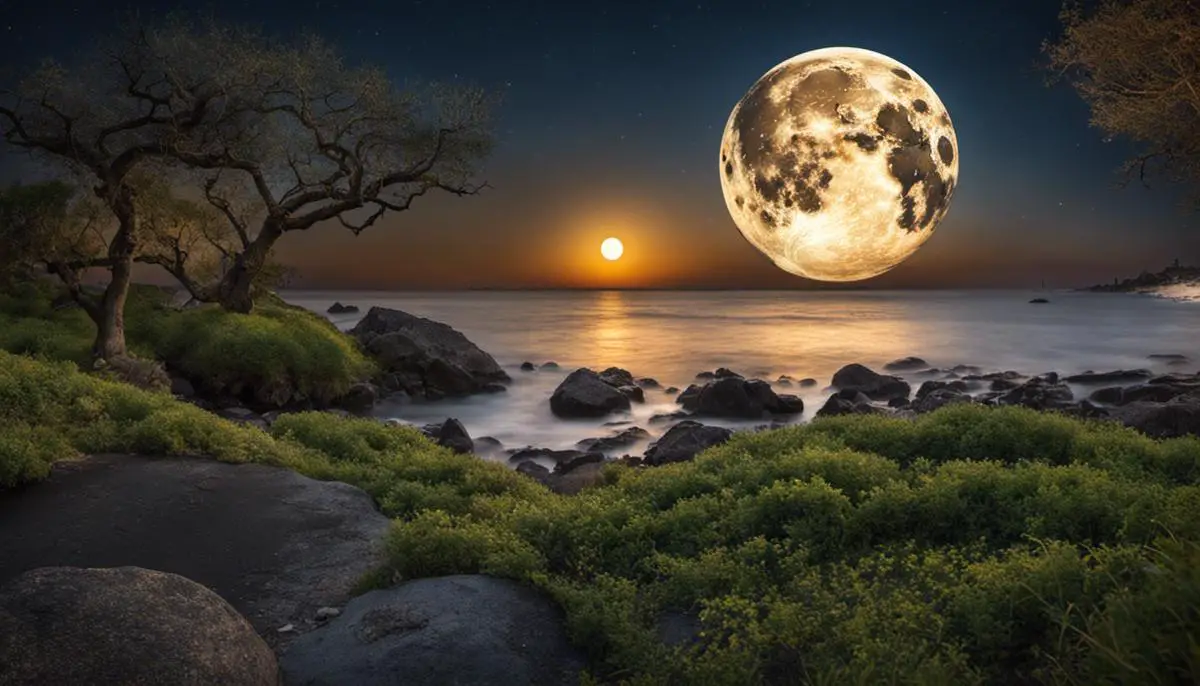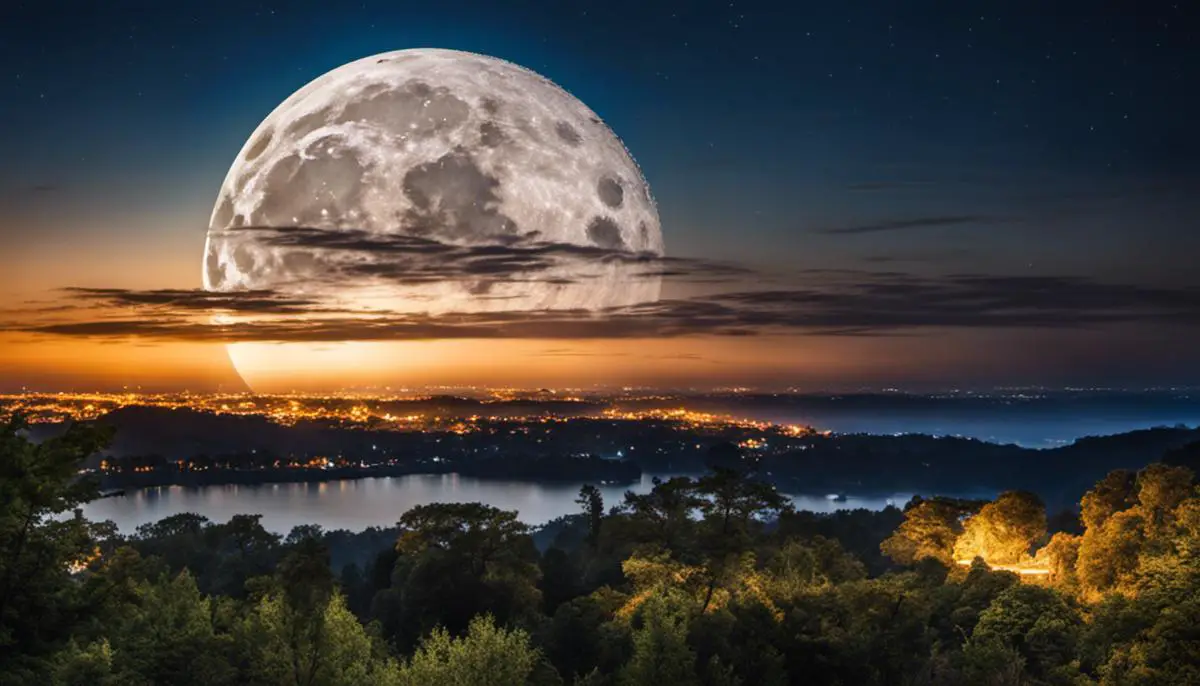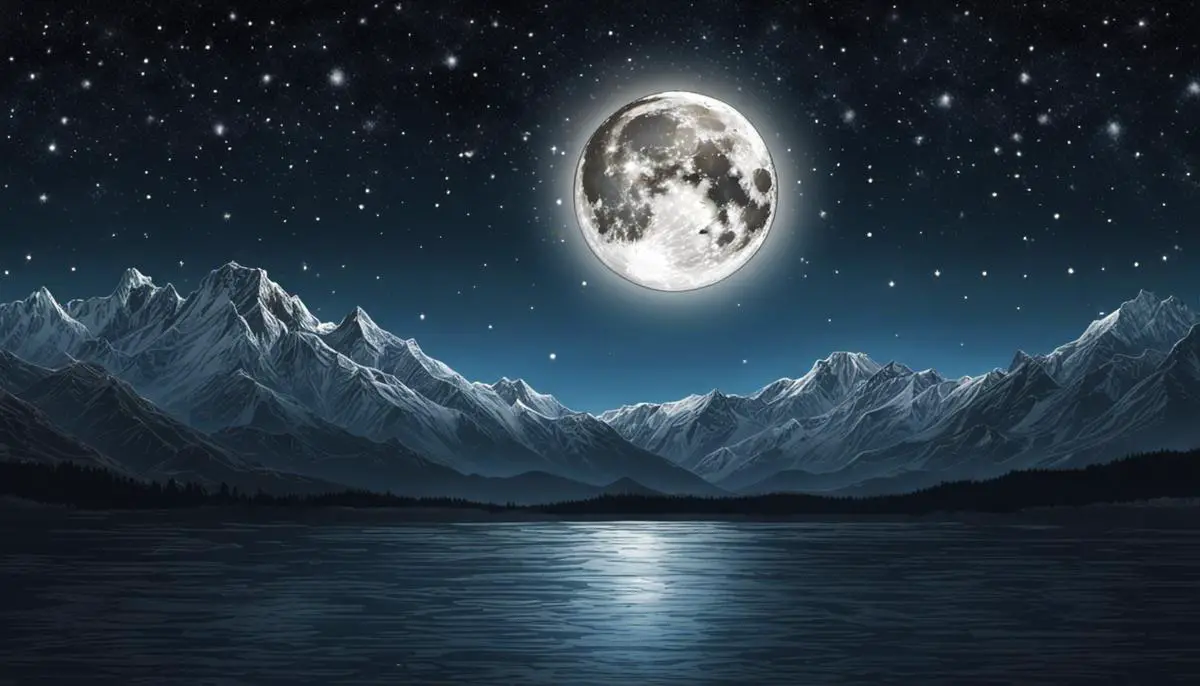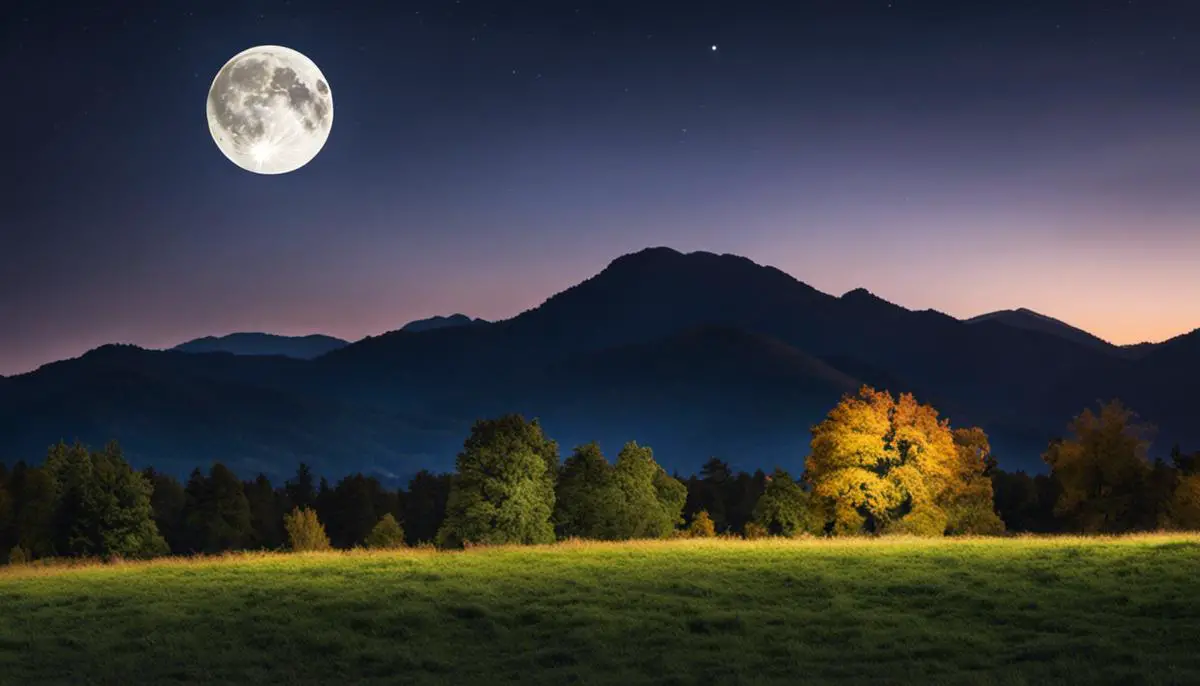Our celestial neighbor, the moon, has always triggered intrigue and curiosity, yet there is one lunar phase that often captivates our fascination more than the rest — the full moon. Every month, as Earth’s sole natural satellite completes its journey, passing through myriad phases, we witness its elaborate dance in the sky, culminating in the spectacle that is a full moon. The October 2023 full moon, however, holds its unique allure, carrying scientific, cultural, astronomical, psychological, and environmental dimensions that are worth delving into. This exploration sets out to peel back the layers of this heavenly cosmonaut, aiming to buffet the observer’s understanding from a scientific perspective, delve into its influence on cultures and history, study any astronomical peculiarities, examine its supposed psychological and behavioral effects, and consider its possible impacts on our environment.
Understanding the Phenomenon of Full Moon
Understanding the Lunar Cycle and Full Moon Phenomenon
A full moon occurs when our planet, Earth, is located directly between the Sun and the Moon, making the lunar surface fully illuminated as seen from Earth. This is part of a larger cycle — the lunar cycle, also known as the moon phase, which spans approximately 29.5 days. This cycle includes several phases, including the New Moon, First Quarter, Full Moon, and Last Quarter.
The full moon phase occurs roughly every month, or more specifically, every 29.5 days, which is known as a ‘synodic month’. This is the period it takes for the Moon to complete a full cycle of its phases. During a full moon phase, the moon appears to be completely illuminated by direct sunlight. However, from a scientific standpoint, the moon is only truly ‘full’ for a fleeting moment when it’s 180 degrees opposite the sun in ecliptic longitude.
Full Moon in October: The Hunter’s Moon
Each monthly full moon has traditional names in folklore. The full moon in October is traditionally called the “Hunter’s Moon”. This name originates from Native American tribes, and also has roots in European traditions. It was known as the Hunter’s Moon as it was a time when game was fattened, and it was time to hunt and stock up meat for the winter ahead.
Impact of Full Moon in General
Scientifically, a full moon’s impact isn’t significantly different from other phases. It doesn’t affect Earth’s tides more than any other phase. However, it might affect some animals’ behaviors, particularly nocturnal species, due to the increased night-time illumination.
Full Moon in October 2023: Facts and Implications
Modern scientific understanding affirms that there is no particular impact tied to a full moon happening in October or indeed any other month. No significant effects on Earth’s natural phenomena or on human behaviour have been identified. However, we’re living in a time where scientific exploration continues, enabling us to understand more about potential connections with lunar events.
However, from an astronomical viewpoint, we can predict that the full moon in October 2023 is scheduled to take place on October 5th, which offers a perfect opportunity for stargazers to avidly observe this lunar spectacle.
One thing that distinctly marks a full moon, particularly around the “Hunter’s moon”, is that the moonrise occurs concurrently with sunset, while the moonset is synchronised with sunrise, providing a ‘full night moonlight’ experience.
Conclusively, although the full moon of October 2023 may not trigger any characteristic scientific implications in comparison to other monthly full moons, it’s an exciting event for those interested in lunar phases and sky gazing. It’s a chance for us to marvel at our celestial companion under peak lighting conditions.

Cultural and Historical Influence of Full Moons
Cultural Associations with the Full Moon
Historically, the full moon has been considered a magical and influential component of our natural surroundings, believed to sway various aspects of human existence. Each monthly full moon carries an exclusive meaning, typically reflecting the seasonal changes of the year it occurs in. The full moon has been attributed to increased emotional sensitivity, prosperity in agriculture, and even modifications in sleep patterns within certain cultures.
Particularly, the October full moon often stirs distinct beliefs and superstitions globally. Often referred to as the “Harvest Moon” or the “Hunter’s Moon”, these terms are rooted in past agrarian societies. The ‘Harvest Moon’ got this title because farmers used to utilise the moon’s ample light to extend their harvesting hours. On the other hand, the ‘Hunter’s Moon’ signifies a crucial phase of gathering food and preparing for the winter months ahead.
How October’s Full Moon Influences Halloween Myths and Folklore
The full moon in October also tends to produce a sense of mystery and spookiness, likely due to its alignment with Halloween in the Western world. In Halloween folklore, full moons – often symbolized as eerie and ominous tokens – are believed to transform ordinary humans into notorious creatures such as witches or werewolves. While this is purely mythological, it is embedded deeply within traditions and continues to add an atmospheric charm to the holiday.
The Impact of the Full Moon on Humans and Animals
Scientifically, the full moon’s luminous splendor provokes an array of responses in both humans and animals. Some studies suggest a correlation between full moons and human sleep cycles. People may experience lighter sleep and vivid dreams during this time. Increased emergency room visits and crime rates during full moons have also been recorded, but these aspects still demand further research to provide decisive evidence.
Implications of the Full Moon in October 2023
As we look forward to the full moon in October 2023, we can anticipate the likely socio-cultural impact given these historical and cultural perspectives. It is a deeply ingrained human instinct to seek meaning in the patterns of nature, and the full moon is no exception. For example, those following agricultural traditions may prepare for a fruitful harvest, leveraging the full moon’s illumination.
Meanwhile, with Halloween festivities under the October moon, we can anticipate a spike in themed celebrations and events. These practices, enlivened by the compelling allure of the full moon, contribute to the cultural enrichment of societies. However, it is crucial to recognize that these impacts, while holding historical or cultural significance, do not have a proven scientific basis.
The Full Moon’s Influence: A Personal Encounter
The influence of a full moon varies from one person to another. To some, the full moon is invigorating and serves as a natural phase for self-reflection and wellness practices. Simultaneously, others may feel the proposed influence on their sleep cycles or emotional wellbeing. Regardless of these individually unique experiences, the full moon of October 2023, similar to those that have come before, is sure to be characterized by a mixture of personal, cultural, and historical significance.

Full Moon and Astronomy
Delving into the October 2023 Full Moon
The full moon of October 2023, also known traditionally as the Hunter’s Moon due to its appearance during the hunting season, is set to emerge on October 5th. Such a naturally occurring event has historically been of great interest to not just astronomers and moon enthusiasts, but also to the wider populace due to its striking beauty and its potential impact on human behavior.
What to Expect in October 2023
During the full moon phase, the moon appears fully illuminated from Earth’s perspective as it lies on the opposite side of the Earth from the Sun. This alignment can create a phenomenon called moon illusion, which makes the moon appear larger on the horizon than it does higher up in the sky. The full moon itself will rise just after sunset, reach its highest point around midnight and set at dawn.
For the October 2023 full moon, it will be visible worldwide, barring potential weather conditions that could obstruct the view. For the best viewing experience, you would want to be as far away as possible from city lights, as light pollution may reduce the visibility of celestial events.
Astrological Implications
From an astrological perspective, full moons are often associated with heightened emotional sensitivity and intensity. While concrete scientific evidence to support this claim is elusive, many people have anecdotally reported experiencing heightened emotions during a full moon. The full moon could also potentially exacerbate existing psychological or physiological conditions, but again, investigations into this issue have so far produced inconclusive results.
Cultural Significance
The Hunter’s Moon holds special cultural significance for various cultures. For Native Americans, this full moon marked the time to hunt in preparation for winter. Today, it not only creates an opportunity for skygazing but also provides an interesting insight into historical survival methods and seasonal cycles.
The Moon’s Impact on Tide
A full moon’s gravitational pull can also lead to more significant tidal fluctuations. Tides are usually higher during the full moon and new moon when the Sun, Earth, and the Moon are aligned. So, during the October 2023 full moon, you can expect higher than normal tides.
Wildlife Behavior
Additionally, the brightness of a full moon affects the behavior of some wildlife. Nocturnal animals like bats and owls may change their hunting habits due to increased visibility, while some birds use the moon’s light for migration. One can possibly observe these behaviors in certain areas around the world during the October 2023’s full moon.
As we gaze towards the skies in October 2023, the full moon promises to deliver a breathtaking display of celestial beauty. This striking event holds cultural, astrological, and scientific significance that culminate in an evening filled with wonder and awe.

Psychological and Behavioral Aspects
Exploring the Psychological and Behavioral Influences of Full Moons
For hundreds of years, the mesmerizing radiance of a full moon has inspired curiosity, spawned folklore, and prompted scientific inquiry. This phenomenon, often referred to as the ‘lunar effect,’ suggests that a full moon can impact both human and animal behavior, purportedly inciting unpredictable or aggressive actions. Numerous studies have delved into such claims and have discovered varying levels of supporting evidence.
Lunar Effect on Sleep
Notably, research conducted at the Sleep Center of the Charité-Universitätsmedizin in Berlin concluded that a full moon could interfere with a person’s sleep. The study found that during a full moon phase, subjects took longer to fall asleep, had shorter sleep duration, and experienced less deep sleep. This phenomenon could potentially cause mood swings or fatigue in some individuals due to sleep deprivation. The full moon of October 2023 might disrupt sleep patterns, possibly leading to such effects.
Full Moon and Mood Swings
The belief that a full moon causes mood swings, heightened emotions, or increased mental illness episodes is widespread, though scientific evidence to support it is limited. A review of over 100 studies in a 1985 edition of the journal Psychological Bulletin found no significant correlation between the full moon and increased mental disorder incidents.
However, in a poll conducted by Britain’s Daily Mail, about 43% of respondents reported experiencing mood swings during a full moon. As such, some people may perceive mood changes coinciding with the full moon in October 2023.
The Lunar Effect on Animal Behavior
The impact of the full moon isn’t limited to humans – animal behavior is also reportedly affected. Some nocturnal creatures, like owls and bats, tend to be less active during full moon phases due to increased visibility to predators. Additionally, certain marine organisms, such as worms and corals, align their reproductive behaviors with lunar cycles. Wildlife behavior alterations could occur during the October 2023 full moon, but overall, the effects are species-specific.
Understanding the Lunar Effect: Fact vs. Fiction
The influence that the full moon is believed to exert on psychological and behavioral aspects is often a subject of debate. While there is a plethora of beliefs associated with the lunar phase, empirical evidence has not always been consistent. It’s worth noting that some of these beliefs might merely be the result of confirmation bias, where individuals anticipate bizarre behavior coinciding with the full moon and then ascribe any deviation from the norm to this celestial occurrence. As we approach the Hunter’s Moon in October 2023, it’s crucial to discern the real from the mythical about the so-called ‘lunar effect’. Regardless of whether this effect is more fiction than reality, the intrigue generated by this phenomenon continues to fuel ongoing investigations.

Environmental Impacts of Full Moon
Wildlife Activities Amid the Hunter’s Moon: A Dance in the Moonlight
The forthcoming full moon in October 2023, aptly named the Hunter’s Moon, is set to cast an unusually bright stage upon which nocturnal animals will carry out their activities. The increased lunar brightness stands to lessen the cover of darkness typically utilized by some creatures, leading to possible changes in feeding schedules and periods of activity. Predatorial species like owls and foxes may find their customary edge over their prey negated by the heightened visibility, inducing possible modifications to hunting strategies.
Conversely, for prey species, this lunar period might present unique opportunities for safer expeditions and nocturnal foraging. And speaking of full moon folklore’s regular protagonists, the bats, they could indeed keep a low profile during this period due to the increased risk of predatorial attention brought on by the enhanced moonlight.
Influence on Insects: A Bright Night’s Commotion
While the impact of the full moon on insects is relatively less studied compared to animals, existing studies suggest that nighttime illuminated by a full moon can have distinct impacts on some insects. For instance, moths are found to be more erratic and active during the full moon phase. Given their primary role as pollinators, such frenzied activity can have ripple effects on the ecosystems they inhabit.
Research has also indicated that the full moon may affect the ‘circalunar’ clock of insects. This internal mechanism governs their physiology and behavior in tune with the lunar cycle, potentially affecting lifecycles and reproduction patterns.
Effect on Tides: Waves High and Mighty
One of the most profound environmental effects of the full moon is on ocean and sea tides. The gravitational pull from both the sun and the moon cause tides. But when the moon is full or new, and the sun, earth, and moon are aligned, spring tides occur marked by the highest high and the lowest low tides. These tidal variations could lead to increased coastal erosion or flooding, especially in low-lying areas.
Impact on Plant Life: Basking in Lunar Light
The full moon’s bright illumination might also potentially influence plant life. Through a process known as moonlight photosynthesis, some plants are able to utilize the moon’s reflected sunlight for photosynthesis. It’s a much less efficient process compared to daylight photosynthesis, but it contributes to a plant’s overall survival, particularly in extreme environments. Moreover, some studies suggest that lunar light could affect plant growth regulation and germination patterns.
Impact on Weather: A Cloudy Connection?
While the link between moon phases and weather patterns is far from definitive, folklore often states that a halo around the moon predicts rainfall or snowfall. The halo effect is caused by the refraction, reflection, and dispersion of light, usually through ice crystals in cirrus or cirrostratus clouds. These clouds often precede wet weather. However, meteorologists argue that while this superstition bears a tiny grain of truth, it should not be solely relied upon for weather prediction.

Steeped in scientific intrigue, cultural lore, astronomical characteristics, psychological theories, and environmental consequences, the full moon of October 2023 promises to be much more than just a radiant orb in the night sky. As we become more informed, it is evident that this astronomical event is a weave of remarkable intricacies and vast complexities. Whether it’s observed through the lens of a telescope, acknowledged in cultural folklore and rituals, investigated from behavioral perspectives, or considered for its impact on the environment, each approach unearths a new way of understanding and appreciating this luminous spectacle. This exploration serves as a reminder of our symbiotic relationship with the cosmos and the moon, our nearest celestial neighbor, that continues to shape, inspire, and mystify us.
FAQ
Does the lunar cycle affect sleep?
There is interest in and ongoing research on the impact of the lunar cycle on sleep habits, albeit the results are not totally definitive. Anecdotal reports of people reporting altered sleep quality during different lunar phases, especially around the Full Moon, have led several studies to hypothesize a possible connection between lunar phases and variations in sleep patterns. Nevertheless, there is insufficient and contradictory scientific data to back up these assertions. The quality of sleep is greatly influenced by a variety of factors, including lifestyle decisions, environmental factors, and individual variances. Even though some studies have found hints of a relationship, the scientific community is still divided on the overall effect of the moon cycle on sleep, and more thorough investigation is required to prove a conclusive link between lunar phases and sleep habits.
How does the lunar moon affect humans?
Scientists have studied, as well as traditional beliefs and mythology, how the lunar moon affects humanity. There isn’t much scientific proof to back up the numerous ancient customs and superstitions that link distinct moon phases to varied effects on human behavior, emotion, and health. The moon’s gravitational pull does have an effect on Earth’s tides, but it has very little effect on any one person. Numerous research have looked into possible relationships between the moon cycle and things like mental health, sleep habits, or fertility, but the findings are frequently conflicting or ambiguous. Even while the phases of the moon may have symbolic or cultural meaning, it’s important to view claims concerning direct, observable effects on human physiology critically because there is still much to learn about the scientific knowledge of these affects.
Why Empaths can’t sleep during a full moon?
The idea that empaths, individuals who are believed to be highly sensitive to the emotions and energies of others, may experience difficulty sleeping during a Full Moon is rooted more in metaphysical and spiritual beliefs than in scientific evidence. According to some spiritual traditions, the energy associated with the Full Moon is considered intense and may affect individuals with heightened sensitivity, including empaths. Believers in this concept argue that the increased lunar energy can lead to heightened emotions, restlessness, or difficulty in calming the mind, thereby affecting sleep patterns. However, it’s important to note that these claims lack robust scientific support, and variations in sleep patterns during a Full Moon could be influenced by a range of factors, including psychological expectations, environmental conditions, or other personal circumstances. As of now, the link between lunar phases and sleep disturbances, especially for empaths, remains largely anecdotal and falls outside the realm of well-established scientific understanding.
What is lunar insomnia?
The phrase “lunar insomnia” is occasionally used to characterize sleep problems that people blame on the moon’s phases, especially the Full Moon. This myth holds that people are more likely to suffer from insomnia or irregular sleep patterns during specific lunar phases—the Full Moon being the most frequently mentioned culprit. Some claim that restlessness, vivid dreams, or trouble falling asleep are caused by the increased brightness of the Full Moon or by its perceived energy impact. It is important to note, though, that there is considerable doubt over the concept of lunar insomnia’s scientific validity. Although Earth’s tides are influenced by the moon due to gravitational pull, conclusive proof of a direct correlation between moon phases and sleep disruptions is still lacking. Complex variations in sleep patterns can be caused by a wide range of causes, such as environmental circumstances, lifestyle choices, and personality variances. Therefore, it is more likely to stem from stories and cultural beliefs than from causes that science has proven to exist when attributing insomnia exclusively to lunar phases.
Why do empaths sleep alone?
The idea that empaths would rather sleep alone stems from the idea that empaths are extremely sensitive people who are able to take in and sense the energies and emotions of those around them. It is believed that sleeping by themselves gives empaths a more peaceful and energetically neutral environment in which to refuel and preserve their emotional equilibrium. People who are powerful or have opposing energies can potentially overwhelm empaths, making it difficult for them to get a good night’s sleep. The idea is not so much based on scientifically established principles as it is on metaphysical and spiritual notions. It’s crucial to remember that preferences for sleeping alone or with people are quite personal and can be impacted by a range of things, not only one’s capacity for empathy. These considerations include personal comfort, sleep patterns, and emotional health.
![]()
